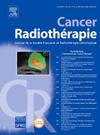放疗在睾丸癌治疗中的作用:来自法国放射肿瘤学学会的建议
IF 1.4
4区 医学
Q4 ONCOLOGY
引用次数: 0
摘要
本文旨在报道法国放射肿瘤学学会(societacranaise de radithacrirapie oncologique, SFRO)关于使用外束放疗治疗睾丸癌的建议。睾丸癌占成人肿瘤的1%,但却是年轻男性中最常诊断的泌尿系统肿瘤。大多数睾丸癌(95%)是生殖细胞肿瘤,包括半细胞瘤和非半细胞瘤肿瘤。监测是睾丸切除术后I期精原细胞瘤的首选,但辅助化疗或主动脉旁放疗仍然是可能的选择。对于IIA/IIB期精原细胞瘤,可以建议化疗或主动脉旁和同侧髂淋巴结照射。对于非半瘤性肿瘤,化疗是标准的治疗方法。靶体积,剂量,分离方案,并考虑器官的危险进行了讨论。提供随访建议,旨在确保早期发现癌症复发和晚期治疗相关副作用。这些指南强调了多学科方法对生殖细胞肿瘤管理的重要性,以及对这一预期寿命较长的年轻患者群体长期毒性的仔细考虑。本文章由计算机程序翻译,如有差异,请以英文原文为准。
Role of radiotherapy in the management of testicular cancer: Recommendations from the French society for radiation oncology
This article aims to report the recommendations from the French society for radiation oncology (Société française de radiothérapie oncologique, SFRO) on the use of external beam radiotherapy in the management of testicular cancer. Testicular cancers account for 1 % of adult neoplasms yet represent the most frequently diagnosed urological tumour in young men. Most of testicular cancers (95 %) are germ cell tumours, which include both seminomatous and non-seminomatous tumours. Surveillance is the preferred option for stage I seminoma following orchidectomy, but adjuvant chemotherapy or para-aortic radiotherapy remain possible options. For stages IIA/IIB seminoma, either chemotherapy or para-aortic and ipsilateral iliac nodal areas irradiation can be proposed. In non-seminomatous tumours, chemotherapy is the standard treatment. Target volumes, doses, fractionation regimens, and considerations for organs at risk are discussed. Follow-up recommendations are provided, aiming to ensure both early detection of cancer recurrence and late treatment-related side effects. These guidelines highlight the importance of a multidisciplinary approach for the management of germ cell tumours as well as careful consideration of long-term toxicities, in this young patient population with a long-life expectancy.
求助全文
通过发布文献求助,成功后即可免费获取论文全文。
去求助
来源期刊

Cancer Radiotherapie
医学-核医学
CiteScore
2.20
自引率
23.10%
发文量
129
审稿时长
63 days
期刊介绍:
Cancer/radiothérapie se veut d''abord et avant tout un organe francophone de publication des travaux de recherche en radiothérapie. La revue a pour objectif de diffuser les informations majeures sur les travaux de recherche en cancérologie et tout ce qui touche de près ou de loin au traitement du cancer par les radiations : technologie, radiophysique, radiobiologie et radiothérapie clinique.
 求助内容:
求助内容: 应助结果提醒方式:
应助结果提醒方式:


